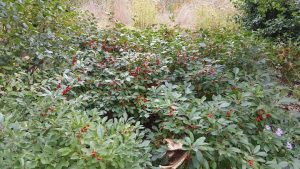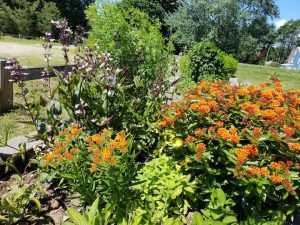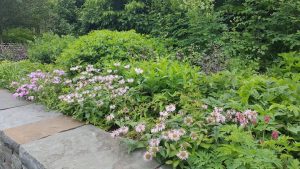Question: What are important considerations for plant selection when designing a sustainable landscape?
Answer:

Proper plant selection is the most important step in designing a sustainable landscape.
- “Right plant, right place” is the fundamental principle for the environmentally sound management of landscapes. Plants should be selected for not only aesthetic value, but also because they are adapted to the existing soil conditions, available water, microclimate, and space available.
- Biologically diverse plants should be selected to tolerate reduced irrigation (once established), fertilizer, and soil amendment inputs.
- Establishing strong, healthy, vigorous plantings is crucial for pest management in sustainable landscapes. A vigorous, healthy, unstressed plant can usually survive, avoid, or outcompete many potential disease, insect, and weed pests without further intervention.
- Native plants are best adapted to the local soils and site conditions. Incorporating native plants helps to restore local ecosystems that support a wide variety of indigenous and beneficial insect, bird, and animal species. Over time, as these native plants become established, they can increase biodiversity and contribute to a reduction in expense and time spent on maintenance.
- A healthy and diverse landscape supports naturally occurring beneficial insects. Native predators and parasitoids will help control harmful pests when provided the opportunity and necessary habitat for their survival. Many practices that support pollinators also support pest-controlling insects.
For more information, see UConn Extension Native Plant & Sustainable Landscaping Guide, available here.
Question: How do I maintain my garden in a more sustainable way?
Answer:


- Perform a soil test when renovating both landscapes and turfgrass areas. Find instructions at soiltesting.cahnr.uconn.edu/sampling
- Consider the soil characteristics, climate, sun exposure, water conditions, and pest possibilities when selecting plants.
- Utilize native plants wherever possible, incorporating them into the landscape, along with annuals, to maintain season-long color and aesthetic interest. Native plants can be interplanted in existing landscapes, even among non-native plants.
- Group plants with similar watering, pH, fertilizer, and light requirements together to allow for the most efficient use of resources.
- Ensure that the mature height and width of each plant is factored into the landscape design to avoid the need for excessive pruning or regular replacement.
- Select more stress-tolerant species or cultivars to manage periodic dry/wet conditions. Where feasible, design with drought tolerant and low water use plants that require minimal irrigation. Where irrigation is necessary, utilize high‐efficiency irrigation systems (e.g., drip irrigation) or recycled water features in all landscaped areas for maximum efficiency.
- Utilize a diverse range of plant species. Choose plants that offer ornamental interest in every season. Bark, foliage, fruit, and fragrance are ornamental characteristics to consider, in addition to flowers.
- Select flowers with a variety of colors, shapes, sizes, heights, and growth habits to attract pollinators. Choose plants with a wide range of flowering times to extend the forage season and attractiveness of the planting. Select plant material not regularly browsed by deer.
- Plant in “floral clumps,” which imitates the way plants naturally seed themselves and is both aesthetically pleasing and beneficial for pollinators. It is easier for pollinators to find and benefit from plantings when there are five or more of each pollinator-supporting species in a group.
- Consider including species that support both butterfly/moth larvae and adults. Many butterfly and moth species are highly specialized, requiring specific plants for their survival, especially for their larvae. For example, monarch caterpillars can only survive by consuming milkweed plants. Many trees, including oak, maple, and willow, also serve as butterfly/moth larval host plants. While larval host plants will endure some damage as insects or other wildlife consume their leaves, native plants can tolerate and thrive in balance with the native insects that depend on them for survival.
- For lawn areas, select improved and low-maintenance cultivars of turfgrasses suitable for home lawns, with improved drought tolerance and pest resistance. Consult UConn Extension specialists. Several national programs evaluate turfgrasses, including National Turf Evaluation Program (NTEP), Alliance for Low Input Sustainable Turf (ALIST), and Turfgrass Water Conservation Association (TWCA). UConn serves as an evaluation site for reduced input or low maintenance turfgrasses.
For more information, see UConn Extension Native Plant & Sustainable Landscaping Guide, available here.
By Vickie Wallace and Alyssa Siegel-Miles, UConn Extension
Visit https://publications.extension.uconn.edu/answers/ for more answers to your questions.